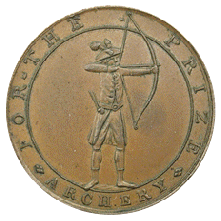 EARLY TOKEN HISTORY
EARLY TOKEN HISTORY
Written by William McKivor
all images owned by www.thecoppercorner.com
18th CENTURY PROVINCIAL TOKENS ("CONDER" TOKENS)
Paul and Bente Withers, in their wonderful new reference volume on the 19th Century penny and halfpenny tokens entitled British Copper Tokens, 1811-1820 have a superb eight page introduction to the tokens and the era in which they were produced. The introduction covers the history in great detail — really wonderful detail. As this introduction to the series is meant to discuss the tokens themselves, it will be much shorter. However — if you are interested in this wonderful series — “Withers” is a must!!
The tokens issued during the 1811-1820 period were really quite different from the pieces that had proceeded them in the latter days of the 18th Century. A good number of events occurred that led to the manufacture of the pieces — with the usual reason leading the way. There was a shortage — once again — of small change.
Here, we must go back in time slightly — to 1797. George III effectively halted the “Conder” token issue by producing penny and halfpenny coins in that year. They were followed by other issues of copper coin in 1799, 1806, and 1807. It would seem that there would have been plenty of small change. Regretfully for the public, it was not to be. As we have discussed in other sections, the basis of acceptable money in the era was to have the coin be of correct weight. In other words, the value of the metal should be close to the value of the coin. If the coin is light weight, it does not contain enough metal — be it silver, gold — or copper, in this instance.
After 1797, the price of copper increased, leading to the coinage of 1799 having less copper in it than the issue of 1797 — though the VALUE was the same. The issues of 1806 and 1807 were similarly reduced in weight, because of a further rise in the price of copper. This led — as you might expect — to the melting of the earlier issues — which were now worth quite a bit more than face value! This increase in the value of copper was caused by the need of the metal for munitions — Britain was in the middle of a war.
The long and costly war with Napoleon of France — and the war against the USA in 1812 — badly depleted the country’s resources. The government was quite occupied with pressing matters, both at home, with a very restless population, and abroad. Producing useful coin of the realm was important — but only to the people. For the ministers in charge of such things, it was not important enough. Nothing was done to relieve the problem.
Britain was also in the middle of the industrial revolution — which, by applying steam power to more and more industries, was escalating at a great rate. It was like a monster that feeds on itself — the more efficient a factory becomes, the more it produces — making more work in other fields. Steam power also meant that mills did not have to be located by a stream because of the need for a waterwheel — they could be located where the workers were, in the cities and towns.
Thus, with the expanding economy, the need was there for coin in ever increasing amounts. The earlier coin had, as we have seen, largely been melted for its value as a metal. It was at this juncture that the price of copper began to drop. Copper mines suddenly had an abundance of copper — and the country needed small change. It was a natural that they would decide to help themselves, as well as help the country — and produce small change. The government — once again asked to produce copper coin for the use of the public — did nothing.
The copper tokens produced beginning in 1811 were mostly penny issues. Very small issues of Threepence, Twopence, Halfpennies and Farthings were made, but the prices dictated that the Penny was the most needed coin. Though they were made until 1820, the vast majority of the pieces were produced in 1811 and 1812. Strangely, even a copper Sixpence was attempted. It most likely failed to catch on when the weight of them was re-considered. All Sixpences are very rare today.
Many of these penny tokens were issued by mining interests. Other tokens were issued by merchants, townships, and poorhouses. They were made to the correct weight in most cases, but were quite utilitarian in design and lack any real artistry. Many of the tokens bear legends only, and the shallow designs did not excite collectors at the time. The tokens were made to use — and use them the people did.
This was not to last, however. They were greeted enthusiastically at first — but some of the genuine issuers went bankrupt, leaving the public with tokens that could not be redeemed for real coin. As well, spurious issues once again were made, with the same result — they were not redeemable. The tokens, in general, were being used, and used correctly — they did fill a genuine need. The bad apples in the barrel, however, caused such a cry that the government eventually called a halt to them as well, with the proviso that one poorhouse issue could be in circulation until as late as 1823 without penalty, as recalling them would work a hardship on the poor. The vast majority of the tokens were removed from circulation by decree in 1817.
The token coinage of the 1811-1820 period did not find collector’s standing in line for them. The economy and life of the people was in a constant state of flux — collecting them was not at the top of anyone’s list. As well, the utilitarian designs did not have anyone excited. Few were saved in nice condition — except, most likely, by accident. Though made in fairly large quantities, the tokens were heavily used by a grateful public. This fact leaves us today with very few really nice examples of ANY of the tokens. A collector willing to collect them in Very Fine will do well — anything in Extra Fine or better can be quite difficult.
It is a rewarding series, however. These tokens were issued by industrialists — REAL industrialists, in the midst of the suddenly exploding industrial revolution. Britain was in the forefront of that revolution — leading the way — the steam engines are running, the workers are working 12 hour days, and the tokens tell of the economic realities of the time. All tokens, regardless of when issued, do that — they take the measure of what was going on at the time, and lets us hold it in our hands and contemplate what was — what was to come — and what is.

